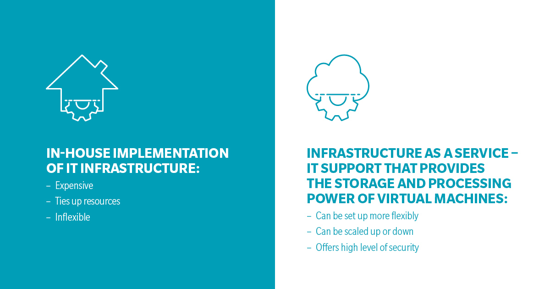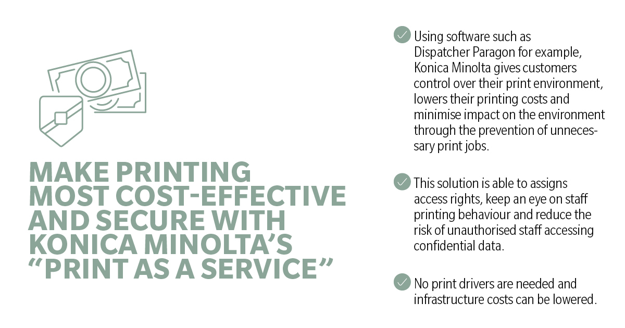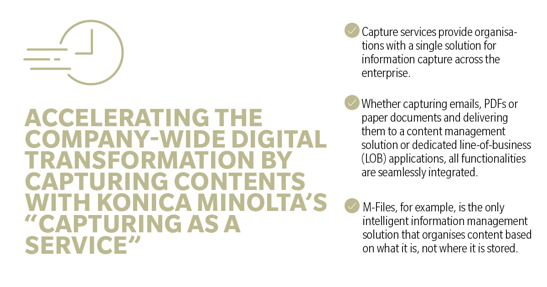The list of reasons why a company benefits from transforming its IT and printing environment to state‒of-the-art technology is extensive: from improving efficiency and increasing cost-effectivity to data safety and protection and the simplification of operational processes. The digital transformation can provide companies with immense support in keeping up with the increased dynamics of today’s business environments. However, SMEs in particular often struggle with their ambitious plans for making such a transformation happen. Scarce internal IT resources, limited budgets as well as legacy software tools can easily exceed their capacities, leading to a situation where SMEs feel locked in in their current set-up and struggle to make ends meet. With the right service provider as a partner, however, these complex challenges can be solved. For smaller organisations, “Infrastructure as a service” (IaaS), “Software as a service” (SaaS) and “Print as a service” (PraaS) are door openers to benefitting from solutions previously only available to companies with large-scale IT departments. The average environment uses 53% non-cloud services, whereas 23% is already covered by SaaS and 16% by IaaS.[1] SMEs, above all, want to increase the cloud share. It is therefore no surprise that the markets for such services are expected to grow significantly. Gartner predicts the market for SaaS to reach USD 110 billion by the end of 2020.[2] But how can companies successfully make such a transition happen? By siding with a partner who understands and addresses their specific challenges – and then offers an overall approach for their needs.
Meeting the IT challenges of today and tomorrow with “as a service” solutions

Digital information and data have become some of the most valuable company assets because they now serve as the basis for making sound business decisions. To be able to take good care of these invaluable assets, a company’s IT system has become the crucial lever. The speed of technological evolution is gaining momentum, and the complexity of applications and on-premises IT solutions is growing fast. In the case of SMEs in particular, it therefore becomes increasingly hard to stay up-to-date with their IT systems. Various reasons play a key role here as the European SME Survey 2019 shows[3]: issues with IT security (28%), lack of digital skills in-house (27%), shortage of skills on the labour market (25%) and lack of financial resources (24%). Many companies neglect digital development because of exactly these reasons, and they are now starting to pay the price for it – in terms of error-prone legacy systems and inefficient use of time, resources and budget. As Konica Minolta’s IT pain point study shows the most severe consequences then follow shortly thereafter: wasted time (41%) and costs (35%) to solve IT problems, decreased employee productivity (37%) and reduced quality of work (35%)[4]. In addition, costs for buying, maintaining and servicing proprietary software and IT infrastructure solutions are topics smaller companies struggle with in particular. While IT and printing can pose challenges to SMEs, it is essential that they keep track in this field. Here a service partner can make the difference – transforming these challenges into benefits “as a service”.
Creating a tailored, all-encompassing IT platform through a combination of “Infrastructure as a service” (IaaS), “Software as a service” (SaaS) and “Print as a service” (PraaS)
For most users in businesses, the printing and IT environment is invisible – in the sense that it completely blends in with their everyday work lives. It only becomes visible when it does not perform as hoped, and then it eventually becomes an annoyance. Tolerance for hiccoughs is also decreasing, as user experiences with private devices become more and more seamless. However, in reality, corporate IT is far more complex. It has to be capable of seamlessly unifying a wide variety of different applications and processes while ensuring exactly the right amount of computing power so that the systems run smoothly. Plus, it must maintain the highest level of security at the same time. This is less of a challenge to large organisations with plentiful resources than for SMEs. Therefore, those who take advantage of managed services for IT infrastructure as well as tailored software and printing environments can bear great potential.

“Infrastructure as a service”: SMEs do not want to keep the operational responsibility for IT infrastructure in-house. If possible, they want to pass it off to a reliable and capable partner who relieves customers of the burden of maintaining their own infrastructure. IaaS makes it possible to buy professional IT support that provides the storage and processing power of virtual machines. In-house implementation would be far more expensive and would tie up many more resources. It is also very inflexible due to the fact that the needs of companies may vary in increasingly dynamic markets. The infrastructure used – when deployed “as a service” – for the organisation can be set up far more flexibly and be scaled up or down based on the resources required at that specific moment in time. The level of security external providers can offer, including anti-virus, back-up and update management and security monitoring, is at least just as important.

“Software as a service”: the IT ecosystem of many businesses, especially when it comes to software being used, often has one thing in common with natural ecosystems – but unfortunately not in a positive sense: it is organically grown. This may be a positive trait for a biological habitat as it stands for stability. In IT, however, this means that over time a plethora of semi-compatible legacy programmes for different business processes are put into place. They often make workflows more complicated and arduous than necessary. At the same time, replacing one software can also trigger a cascade of necessary changes in other programmes. With “Software as a service”, the partner manages these solutions and, as the single point of contact, also takes care of all related issues. This frees up internal personnel resources and renders time-consuming training unnecessary. Furthermore, costs can be reduced because the “Software as service” package contains the management of licences as well as the configuration, maintenance and continuous updating of software. Additionally, with cloud-based SaaS solutions such as Microsoft Office 365, the collaboration between internal teams and external team members can be achieved easily. By offering these solutions as a managed service, the latest state of security measures and compliance to all necessary data regulations can be ensured without exception.

“Print as a service”: for many SMEs, handing over the management of the printing environment to an external supplier may seem not as beneficial as relying on IT infrastructure or software as a service. After all, the printer can be seen as just another peripheral device that requires attention once in a while, like replacing the toner cartridge and resolving a paper jam from time to time. “A dedicated partner can help get much more out of the local printing environment: the level of security and privacy protection for sensitive information can be increased by including dedicated solutions for secure document handling. At the same time, workflows can be optimised and both capital and operational expenditures reduced”, explains Philip Plischke. “Most of all, however, “Print as a service” means that there is one less arduous task for already stretched internal IT resources to deal with.” Here, too, a detailed analysis of the company’s set-up and needs is key to determining the best approach and linking the printing infrastructure seamlessly into content workflows.
Konica Minolta’s “as a service” approach and solutions for its customers
To be truly effective, an “as a service” approach for one field must also consider the resource set-up and needs in the other areas: the IT infrastructure and its virtual machines need to be optimised to handle the data flows created during software set-up and workflows enabled in the software approach. The printing and scanning infrastructure has to ideally fit the information management set-up and so on. ”This demonstrates how valuable a strong and broadly set-up service provider such as Konica Minolta can be in the development and implementation of such a holistic yet tailor-made approach”, says Philip Plischke. “Ultimately, the goal of every company is to be able to focus its resources on its core business. Ideally, the IT and printing environment supports the company without taking up too many resources. The path to achieving this starts with a thorough analysis. For us, this means analysing our customers’ specific situation, processes and requirements. Only then can we as a cloud service provider deliver exactly the printing or IT infrastructure and software they need. To achieve this, we are able to compose an orchestra of well-selected hardware and software services, which play in perfect harmony with each other in a flexible way. No matter if greater computing power, higher storage capacities, new applications or 24-hour service is required. And most importantly, we back all these services up with a payment concept that only lets customers pay for the resources they actually use.”

Here a variety of services can be included: “Infrastructure as a service” can include an on-premises edge server solution, cloud-managed data capacities or a hybrid cloud solution, which combines both edge and cloud computing. Independent of the infrastructure solutions chosen in each case, all data is secure with Konica Minolta. The data centres are located in Europe, which has the advantage of all data staying within European legislation and not being subject to foreign law, such as the American Patriot Act. Every customer who utilises Konica Minolta data centre storage can also be certain of being in full compliance with regulations like the General Data Protection Regulation (GDPR). At the same time, all computational power and storage requirements are met – without having internal IT teams needing to worry about their adequacy and maintenance.

This goes for “Print as a service” solutions as well. To the customer, only the MFP as a multifunctional device will be visible on site. Konica Minolta takes care of the complete integration into the connected workplace, where every device is being transformed into an intelligent, seamlessly integrated part of the network. For example, take Dispatcher Paragon as a service-based print management solution: it features an advanced set of innovative functionalities designed to give control over the print environment, make fact-based decisions, lower printing costs and minimise impact on the environment through the prevention of unnecessary print jobs. This solution is able to assigns access rights, keep an eye on staff printing behaviour and reduce the risk of unauthorised staff accessing confidential data. No print drivers are needed, infrastructure costs can be lowered, and data-based print audits can be executed easily. Dispatcher Paragon, therefore, makes printing more cost-effective and secure – creating a real impact on a company’s printing.

“Capturing as a service” is a related field that perfectly integrates the printing infrastructure into the data and workflows of the company. Capture services provide organisations with a single solution for information capture across the enterprise. Whether capturing emails, PDFs or paper documents and delivering them to a content management solution or dedicated line-of-business (LOB) applications, all functionalities are seamlessly integrated. M-Files, for example, is the only intelligent information management solution that organises content based on what it is, not where it is stored. Users can connect to existing network folders and systems to make them more intelligent with built-in workflow capabilities and advanced search and filter tools. Taking the step to capture content enables and accelerates the company-wide digital transformation.
A further example for a Konica Minolta “Software as a service” model is the collaboration solution Workplace Go. Workplace Go is a digital workplace that incorporates all the information employees need to increase performance of their daily work together. It offers access to all required content, applications and system notifications as well as a tailored search experience through SharePoint and Delve. In addition, Workplace Go enables unique content management because users can follow their contributions based on likes, views, versions, the current approval status, etc. directly in their personal dashboard.
“With all of our services, we emphasise empowering our customers, whether it be by managing their IT and print infrastructure or their cloud and software environment to help them build their connected workplace as a future-proof environment. In addition, we help them comply with all necessary data security regulations for all these business processes”, explains Philip Plischke at Konica Minolta.
Customer voice: LOWA, manufacturer of athletic shoes from Jetzendorf, Germany
LOWA in Germany is a perfect example of how a company can benefit from a comprehensive “Infrastructure as a service” solution. It shows how internal IT resources can be unburdened: when it came to the company rebuilding its server infrastructure, LOWA decided to collaborate with Konica Minolta as a reliable IaaS partner. After LOWA’s hardware became outdated after a five-year period of operation, Konica Minolta was able to develop and implement a sustainable, future-proof concept which met all necessary requirements. For the implementation of Konica Minolta’s IaaS solution, the company required mirrored storage and server systems that needed to be located in different fire protection areas. In the event that a system or an entire fire area fails, this solution automatically guarantees that applications continue to run uninterrupted to prevent any potential downtime. “Additionally, we wanted to increase our storage capacity and improve our performance – this will enable us to implement new projects”, describes Christian Stöcker, a system administrator at LOWA Sportschuhe, the main goal of the IaaS project.
The key to the success was that Konica Minolta was able to seamlessly migrate most of the customer’s 40 or so virtual machines (VMs) from Microsoft Windows Server 2008 to Microsoft Windows Server 2016. In doing so, the company’s 110 IT users were completely unaffected by the project implementation. Since LOWA’s IT department has a streamlined personnel structure, the company now uses Konica Minolta’s “Infrastructure as a service” solutions for all its implemented infrastructure and hardware. The goal is to reduce the department’s workload in normal operations. These services include monitoring, patch management, back-up services, anti-virus services and first-level and second-level support. As part of the set-up, Stöcker receives information on potential issues or disruptions in real time so that they can be rectified quickly in the background, ruling out downtime in the implementation process to the greatest possible extent.
“As a service” partners can become an integral part of a company’s IT
By having the wide range of options “as a service”, Konica Minolta is able to find the best way to take care of the customer’s needs. The flexibility of the solutions mirrors the flexibility the customers enjoy by utilising them – creating real benefits especially for SMEs. “Ultimately, our goal is for our customers to see the IT, printing, infrastructure and ‘Software as a service’ solutions we offer as an integral part of their own IT. We aim to deliver these services in a seamless manner and intuitive way for customers so that they remain on top of their IT without having to worry about operational processes”, concludes Philip Plischke
[1] 2018 Cloud Computing Survey; IDG; 2018; https://www.idg.com/tools-for-marketers/2018-cloud-computing-survey/
[2] Gartner Forecasts Worldwide Public Cloud Revenue to Grow 17.5 Percent in 2019; Gartner; 2019; https://www.gartner.com/en/newsroom/press-releases/2019-04-02-gartner-forecasts-worldwide-public-cloud-revenue-to-g
[3] Going Digital: the Challenges facing European SMEs; National Promotional Institutions (NPIs); 2019; https://www.kfw.de/PDF/Download-Center/Konzernthemen/Research/PDF-Dokumente-Studien-und-Materialien/PDF-Dateien-Paper-and-Proceedings-(EN)/European-SME-Survey-2019.pdf
[4] IT pain points for SMBs; Konica Minolta & Opinium; 2018; https://newsroom.konicaminolta.eu/smbs-are-settling-for-technology-that-underdelivers-new-survey-reveals--countering-this-konica-minoltas-workplace-hub-is-set-to-simplify-it-for-customers/



